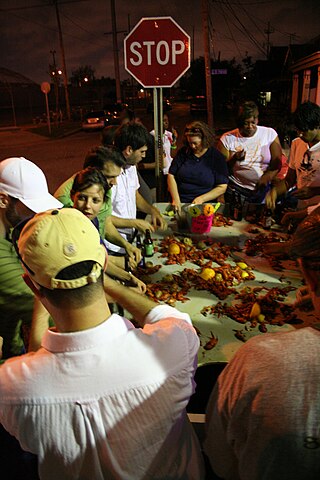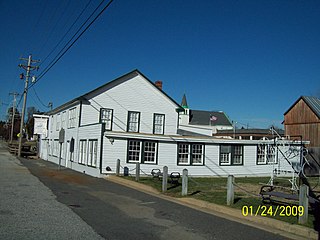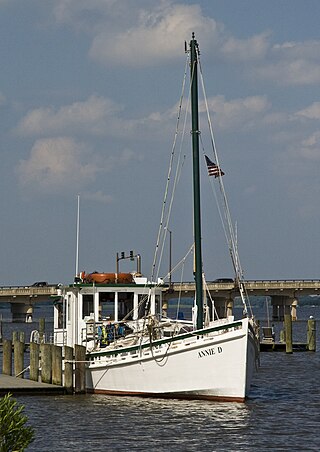Related Research Articles

Seafood is any form of sea life regarded as food by humans, prominently including fish and shellfish. Shellfish include various species of molluscs, crustaceans, and echinoderms. Historically, marine mammals such as cetaceans as well as seals have been eaten as food, though that happens to a lesser extent in modern times. Edible sea plants such as some seaweeds and microalgae are widely eaten as sea vegetables around the world, especially in Asia.

Shellfish is a colloquial and fisheries term for exoskeleton-bearing aquatic invertebrates used as food, including various species of molluscs, crustaceans, and echinoderms. Although most kinds of shellfish are harvested from saltwater environments, some are found in freshwater. In addition, a few species of land crabs are eaten, for example Cardisoma guanhumi in the Caribbean. Shellfish are among the most common food allergens.

Clam is a common name for several kinds of bivalve molluscs. The word is often applied only to those that are edible and live as infauna, spending most of their lives halfway buried in the sand of the seafloor or riverbeds. Clams have two shells of equal size connected by two adductor muscles and have a powerful burrowing foot. They live in both freshwater and marine environments; in salt water they prefer to burrow down into the mud and the turbidity of the water required varies with species and location; the greatest diversity of these is in North America.

Oyster is the common name for a number of different families of salt-water bivalve molluscs that live in marine or brackish habitats. In some species, the valves are highly calcified, and many are somewhat irregular in shape. Many, but not all oysters, are in the superfamily Ostreoidea.

The eastern oyster —also called the Atlantic oyster, American oyster, or East Coast oyster—is a species of true oyster native to eastern North and South America. Other names in local or culinary use include the Wellfleet oyster, Virginia oyster, Malpeque oyster, Blue Pointoyster, Chesapeake Bay oyster, and Apalachicola oyster. C. virginica ranges from northern New Brunswick south through parts of the West Indies to Venezuela. It is farmed in all of the Maritime provinces of Canada and all Eastern Seaboard and Gulf states of the United States, as well as Puget Sound, Washington, where it is known as the Totten Inlet Virginica. It was introduced to the Hawaiian Islands in the 19th century and is common in Pearl Harbor.

San Quintín is a city in San Quintín Municipality, Baja California, located on the Pacific Coast of Mexico. The city had a population of 4777 in 2011. San Quintín is an important agricultural center for Baja California. The city is also an emerging tourist destination, known for its sand dunes and beaches.

Oyster farming is an aquaculture practice in which oysters are bred and raised mainly for their pearls, shells and inner organ tissue, which is eaten. Oyster farming was practiced by the ancient Romans as early as the 1st century BC on the Italian peninsula and later in Britain for export to Rome. The French oyster industry has relied on aquacultured oysters since the late 18th century.

Seafood boil in the United States is the generic term for any number of types of social events in which shellfish, whether saltwater or freshwater, is the central element. Regional variations dictate the kinds of seafood, the accompaniments and side dishes, and the preparation techniques. In some cases, a boil may be sponsored by a community organization as a fund-raiser or a mixer. In this way, seafood boils are like a fish fry, barbecue, or church potluck supper. Boils are also held by individuals for their friends and family for a weekend get-together and on the holidays of Memorial Day and Independence Day. While boils and bakes are traditionally associated with coastal regions of the United States, there are exceptions.

An oyster bar, also known as an oyster saloon, oyster house or a raw bar service, is a restaurant specializing in serving oysters, or a section of a restaurant which serves oysters buffet-style. Oysters have been consumed since ancient times and were common tavern food in Europe, but the oyster bar as a distinct restaurant began making an appearance in the 18th century.

The Virginia Institute of Marine Science (VIMS) is one of the largest marine research and education centers in the United States. Founded in 1940, VIMS is unique among marine science institutions in its legal mandate to provide research, education, and advisory services to government, citizens, and industry. Funding for VIMS comes from the Commonwealth of Virginia, grants and contracts from federal and state agencies, and private giving. The School of Marine Science (SMS) at VIMS is the graduate school in marine science for the College of William & Mary. VIMS offers M.S., Ph.D., and professional M.A. degrees in marine science. The school has 52 faculty members, an enrollment of 80-100 students, and includes 4 academic departments. VIMS' main campus is located in Gloucester Point, Virginia.

J. C. Lore Oyster House, also known as J. C. Lore and Sons, Inc., Seafood Packing Plant, is located at 14430 Solomons Island Road South, in Solomons, Calvert County, Maryland. It is a large two story, rectangular frame industrial building constructed in 1934 as a seafood packing plant. It replaced a 1922 building that was destroyed by the 1933 Chesapeake Potomac hurricane. It is significant for its historical association with the commercial fisheries of Maryland's Patuxent River region, and architecturally as a substantially unaltered example of an early-20th century seafood packing plant. It has been adapted by the Calvert Marine Museum to house exhibits and many of its original spaces, artifacts, and records have been incorporated into them.
Tangier Sound is a sound of the Chesapeake Bay bounded on the west by Tangier Island in Virginia, and Smith Island and South Marsh Island in Maryland, by Deal Island in Maryland on the north, and the mainland of the Eastern Shore of Maryland and Pocomoke Sound on the east. It stretches into Virginia as far south as Watts Island.

An oyster buy-boat, also known as deck boat, is an approximately 40–90 foot long wooden boat with a large open deck which serviced oyster tongers and dredgers. Similar in function to sardine carriers, buy boats circulated among the harvesters collecting their catches, then delivered their loads to a wholesaler or oyster processing house. This spared the fishermen the task and its downtime, allowing them to catch more oysters. Buy-boats also bought seed oysters, or spat, for planting in oyster beds.
The Suminoe oyster, is a species of true oyster which inhabits intertidal hard grounds and substrate, as well as muddy creeks of warm estuaries throughout the western Pacific. It is large and flat in appearance and almost identical in gross morphology to Crassostrea virginica.

Taylor Shellfish Company is an American seafood company based in Shelton, Washington. It is the country's largest producer of aquaculture (farmed) shellfish and has locations across Western Washington. The Taylor family started raising Olympia oysters in the 1920s. In the current form, the company, privately held, was started in 1969 as Taylor United by brothers Edwin and Justin Taylor, grandsons of James Y. Waldrip, an early Washingtonian who came to Seattle to work rebuilding after the Great Seattle Fire of 1889 before moving south and founding the Olympia Oyster Company in the 1890s. Waldrip's company farmed the Olympia oyster found only in South Puget Sound. Justin Taylor, born 1921, the oldest oyster farmer on Puget Sound in the early 2000s, died in 2011.

Flying Fish Company is a sustainable seafood company which operates a fish market, restaurant, and food cart in Portland, Oregon.
Ward Oyster Company is a cage oyster farm headquartered in Gloucester County, Virginia, and one of the largest cage oyster farms on the U.S. East Coast. Established in 1986, the company sells 4 million oysters and tens of millions of larvae each year. The company's oyster nursery is located near the Ware River and its aquaculture oyster farm is located in Mobjack Bay. The company is also involved with oyster restoration projects in the Chesapeake Bay.
Handy Seafoods is one of the oldest seafood processing companies in the United States, and one of the largest crab suppliers in the U.S.
References
- 1 2 "Bevans Oyster Co Inc - Company Profile and News". Bloomberg.com. Retrieved November 11, 2023.
- 1 2 "Bevans Oyster Company". Superior Foods Co. Retrieved November 11, 2023.
- ↑ Livie, Katherine J. (October 26, 2015). Chesapeake Oysters: The Bay's Foundation and Future. Arcadia Publishing. ISBN 978-1-62585-392-9.
- ↑ "Minutes of Work Session of the Newport News City Council". 2019.
- ↑ Kobell, Rona (November 1, 2010). "The Legacies: Shucking houses join forces to create a sustainable local oyster harvest". Bay Journal. Retrieved November 11, 2023.
- ↑ "About Bevans Oyster Company". www.bevansoyster.com. Retrieved November 11, 2023.
- ↑ "Ronald Bevans, Bevans Oyster Co: Profile and Biography". Bloomberg.com. Retrieved November 11, 2023.
- ↑ "Bevan". Supreme Lobster. Retrieved November 11, 2023.
- 1 2 3 Gifford, Bill (March 27, 1994). "Shell Shock". Washington Post. ISSN 0190-8286 . Retrieved November 11, 2023.
- ↑ "Business Makes the Most of Family Ties, Oysters". Daily Press. December 26, 2003. Retrieved November 11, 2023.
- ↑ Interstate Certified Shellfish Shippers List. U.S. Food and Drug Administration. 2003.
- ↑ Karsnitz, Vivian; Karsnitz, Jim (1997). Oyster Cans. Schiffer Publishing, Limited. ISBN 978-0-88740-462-7.
- ↑ "Bevans Oyster Company Products". www.bevansoyster.com. Retrieved November 11, 2023.
- ↑ Stewart, Melissa (November 28, 2017). "6 Of The Tastiest Ways To Eat Oysters In Virginia - Savor Virginia" . Retrieved November 11, 2023.
- 1 2 "Oyster catch a mere shell of the past". Chicago Tribune. April 6, 2003. Retrieved November 11, 2023.
- ↑ Fleming, Jay (2016). Working the Water. Jay Fleming Photography. ISBN 978-0-9977468-0-8.
- ↑ "Bevans Oyster Company- Aquaculture". www.bevansoyster.com. Retrieved November 11, 2023.
- ↑ Mann, Roger; Southworth, Melissa; Fisher, Robert J.; Wesson, James A.; Erskine, A. J.; Leggett, Thomas (2016). "Oyster Planting Protocols to Deter Losses to Cownose Ray Predation". Journal of Shellfish Research. 35 (1): 127–136. doi:10.2983/035.035.0114. ISSN 0730-8000. S2CID 87622886.
- ↑ "Virginia Fishery Resource Grant Program Legislative Report 2012". repository.library.noaa.gov. Retrieved November 11, 2023.
- ↑ Best Management Practices for the Virginia Shellfish Culture Industry (PDF). Virginia Marine Resources Commission. 2008.